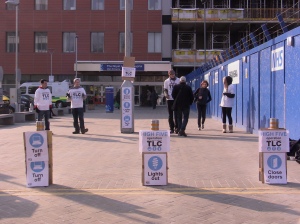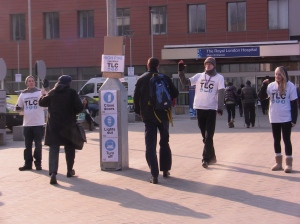I have already expressed a passion in previous blog posts for collaborative consumption and building communities but this has only been exagerated by signing up with IDEO‘s online platform OpenIDEO. Rachel Botsman recently posted a Twitter message that said successful collaborative consumption ventures ‘come down to two golden rules: convenience & choice’. This has proven to be very true – OpenIDEO has been my choice to join and it is very convenient to use, especially if you already think in a socially orientated way!

OpenIDEO logo
The online platform was set up to encourage people to design better together; crowd source information, build on others ideas and come up with sustainable solutions that can be implemented to help a community in some way.
I love the fact that it is unintrusive; I can browse the posted inspirations, read about the various challenges, choose which ones I want to take part in, post as many pieces of inspirations and/or concepts as I wish, comment on as many as I wish, applaude, bookmark, build…. you name it, they have thought about it. If I wanted, I could choose to be a passive member of the community. I could log on once in a while and simply read what has been added. On the other hand, anyone with an inquiring mind or slightly competitive nature will want to add inspiration, post concepts and build on other people’s posts.

OpenIDEO design quotient
The ‘design quotient’ adds another engaging aspect; it is a pie chart which shows how many points you have earnt for taking part in the challenges – what a fantastic way to encourage people to return to the site. I’m not sure if it is deliberate but it is not always that obvious where your points have come from – points definitely get added when someone has built on your idea but you do have to dig around to find out where from!
I first heard about OpenIDEO when Tom Hulme presented it at InterSections2011 in Cornwall at the start of March. He gave a very powerful and captivating talk about how the platform has grown and how building online communities in turn helps so many people around the world. I was intrigued and wanted to learn more…. Described on the website as ‘a place where people design better, together for social good. It’s an online platform for creative thinkers: the veteran designer and the new guy who just signed on, the critic and the MBA, the active participant and the curious lurker. Together, this makes up the creative guts of OpenIDEO’. It has been designed to be inclusive, community-centred, collaborative, optimistic and always in beta (open to continuous improvement). These are all words which are core to being a successful social innovator.
I highly recommend watching this video which explains how OpenIDEO works:
– No one should ever be left out because they are not a ‘designer’ or feel they are not creative.
– If socially orientated people (or anyone!) do not think community, they will get left behind and isolated at some point.
– Sharing ideas, knowledge, insight and experiences is essential for an idea to blossom. Two people with the same challenges can come up with very different concepts yet help each other with what they have learnt.
– I do not believe in pessimism
– Being open to continuous improvement is a very brave yet realistic point to make. How can your idea ever be 100% finished, especially as society is forever changing?

Example concept for food production challenge
The challenges are set with industry partners on real life problems which is another reason why I have become so attached to the community. I know that any inspiration, concept or evaluation of another concept I contribute with can help to build on the ‘winning concept’ which in turn will make a difference for many people in the world. The industry partners are able to take the well thought through ideas into the situations they are required in.
The blog ‘Failed Robot‘ has a interesting write up on the platform which shows a diagram to help explain who gets involved and why. Some great thinking has gone into why people take certain actions and this is particularly interesting when related to social issues within an online community.
Well done, OpenIDEO for
– being slightly addictive; twitter feeds are posted to show you the latest activity,
– for capturing content; the OpenIDEO community tribunal is regularly published providing an overview of the latest posting and stories and
– for allowing members to really feel part of a community; testimonials can be written, applauding can be given, comments are welcomed and the OpenIDEO community champions are fantastic at helping build on ideas.
It doesn’t matter what your background is, what your nationality is or what culture you are from, we can all learn from each other and this is fantastic. It removes any barriers from communicating with other members and instead encourages collaboration between like minded people.

IBM Start Jam
Another example of successful online collaboration was this week’s
IBM Start Jam. A two day event of collaborating on sustainable innovation took place online and a vast number of people took part. Guest contributors came on for set amounts of time while other people simply contributed over the 48 hours. The online platform appeared to be aimed at sustainability consultants, innovation managers, CSR consultants and corporate organisations.
Set up to encourage innovative collaboration around the globe with multidisciplinary and open mindsets, the Start Jam brought ‘different perspectives together to discover new solutions to long-standing problems’. IBM wanted to work across industries, disciplines, and national borders which they managed to do. I didn’t find the interface very intuative but once a question had been posted and people started to reply, the threads grew and I was soon hooked on reading all the responses. Seeing how conversations developed, how people responded and how focused people were on the original question fascinates me. Some people really thought on a corporate level yet the posts I could relate to more were the local, community focused ones. It didn’t mean they were not as relevant, I just felt they were more true to real life situations.
As the Start Jam was only for a short period of time (unlike OpenIDEO which is ongoing) it meant that people tended to have short bursts of collaboration (maybe in their break time or time allocated during their day to take part) which to me took away the community element. If you commented on someone’s post, they were less likely to comment back. This could have been because they had logged off and felt they were done with their contribution or because there was no incentive (no Design Quotient) to return!
I have to questions why these types of online platforms and community builders only seem to happen in the sustainability and social innovation sectors? Are other industries less happy to share information or maybe they do not see the power of building a community around a subject? Maybe their community are not ready or do not have the time to take part in an online platform? I think it all comes down to design thinking – design thinkers understand the need for concise storytelling, collaboration and are able to take a small piece of inspiration and realise it into a sustainable solution efficiently. This has to be done through engagement, empathy, prototyping (or all three!) and realising that it takes a team of different disciplines for an idea to be successful.
I wish I could have taken part in the service design, Global Jam 2011 where service designers in different countries set up Jams together to design brand new services inspired by a shared theme. Time and effort are required for these types of events but service designers and social innovators are forever inspired by them!











